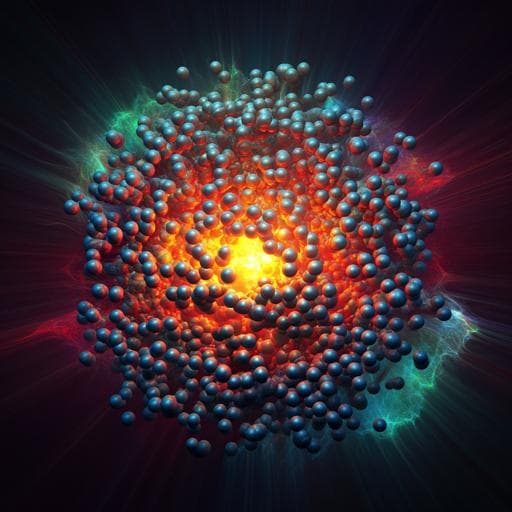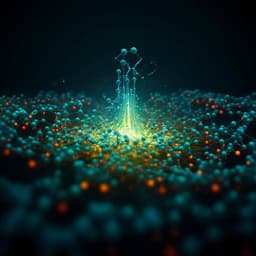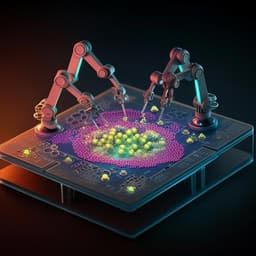
Chemistry
Plasmon-driven chemical transformation of a secondary amide probed by surface enhanced Raman scattering
A. Dutta, M. Ončák, et al.
This cutting-edge study explores the fascinating reactivity of N-methyl-4-sulfanylbenzamide (NMSB) at gold and silver nanoparticle aggregates under plasmonic excitation. By employing surface-enhanced Raman scattering (SERS), the authors reveal a hot electron-mediated transformation of NMSB into p-mercaptobenzamide and p-mercaptobenzonitrile, showcasing an unexpected non-thermal reaction pathway. Discover the exciting findings from this collaborative research by Anushree Dutta, Milan Ončák, Farhad Izadi, Eugene Arthur-Baidoo, João Ameixa, Stephan Denifl, and Ilko Bald.
~3 min • Beginner • English
Introduction
The study investigates plasmon-driven photocatalysis at metal–dielectric interfaces, where decay of surface plasmons generates energetic hot electrons capable of driving surface reactions under mild conditions and at longer wavelengths than conventional photochemistry. Prior work has established plasmon chemistry for small molecules and model organics, and extended it to biomolecules in hot spots. Mechanistic frameworks include DIET/DIMET and formation of transient negative ions (TNIs) that can undergo non-thermal bond cleavage along repulsive potentials, akin to dissociative electron attachment (DEA). Charge transfer from plasmonic metals to adsorbates can proceed via direct (chemical interface damping) or indirect (Landau damping) mechanisms, depending on alignment of adsorbate frontier orbitals relative to the metal Fermi level. Reactions can also involve hot-hole transfer from the adsorbate HOMO. These processes occur far from thermal equilibrium on femtosecond timescales and are influenced by shifts of HOMO–LUMO gaps upon adsorption, interfacial chemistry (ions/ligands), photon density/energy, and external temperature. Against this backdrop, the work focuses on the reactivity of a secondary amide motif near plasmonic surfaces, selecting N-methyl-4-sulfanylbenzamide (NMSB) as a model. Key questions are: (a) What fragmentation products arise from plasmon-induced dissociation of NMSB in nanocavities? (b) How do photon density, wavelength, external temperature, and plasmonic material (Au vs Ag) affect reactivity? (c) What is the nature (thermal vs non-thermal) of reactivity under visible excitation? The approach combines in situ SERS to both trigger and monitor reactions, with support from gas-phase DEA and DFT to propose mechanisms.
Literature Review
The paper situates its work within established plasmon-induced chemistries demonstrating hot-carrier-driven transformations of small molecules and organics, and peptide reactivity in plasmonic hot spots. It references DIET/DIMET frameworks and TNI-mediated non-thermal pathways, including prior observations of DEA-like mechanisms in plasmonic systems. The role of charge transfer (direct vs indirect), hot-hole processes, and interfacial effects (coadsorbates, orbital alignment, plasmon resonance) are highlighted as determinants of rate and selectivity. Prior reports show stronger plasmonic activity near certain wavelengths for aggregated Au/Ag, and that Ag typically produces more hot electrons than Au. These inform expectations about wavelength/material dependencies observed here.
Methodology
Materials: NMSB (≥95% purity), citrate-stabilized AuNPs and AgNPs (40 nm diameter), Si wafers, Milli-Q water. Nanoparticle functionalization: AuNP and AgNP dispersions were purified by centrifugation (7000 rcf, 8–10 min, 20 °C), mixed with 2.5 mM ethanolic NMSB, shaken 2 h at 30 °C (400 rpm) for chemisorption, then washed (centrifuge 7000 rcf, 10 min, twice) and redispersed in 20 µL water. Samples were drop-cast (10 µL) onto cleaned Si substrates and dried at ambient conditions. SEM: Hitachi S-4800, 2 kV accelerating voltage, 5.0 mm working distance. SERS measurements: WITec alpha300 microscope with 632/633 nm and 785 nm excitation (100× objective, NA 0.9). Time-series SERS acquired to follow reaction; spectra baseline-corrected (WITec Project 5) and analyzed in Origin 9.1. Bare nanoparticle SERS shown in Supplementary info. Temperature-controlled SERS: Samples drop-cast on a smart substrate (functionalized coverslips with integrated transparent heater and temperature probe) and measured using an Interherence VAHEAT controller over 25–85 °C. Kinetic analysis: Under CW illumination, assuming a constant time-averaged hot electron concentration, pseudo-first-order fractal kinetics were applied: ln([NMSB]t/[NMSB]0) = k_r (t^{1−h}) with fractal term h; SERS peak intensity at 1320 cm⁻¹ (amide III of secondary amide) used as a proxy for [NMSB] decay to extract k_r at varied laser powers, wavelengths, substrates, and temperatures. DEA experiments (gas phase): Crossed electron–molecular beam instrument under high vacuum (~1×10⁻⁷ mbar). NMSB introduced via a heated oven/capillary (353 K). Electron source: hemispherical electron monochromator (HEM), energy resolution ~110 meV FWHM, current 40–45 nA. Negative ions analyzed by quadrupole mass analyzer with channel electron multiplier detection. Electron energy calibrated to the Cl⁻/CCl₄ 0 eV resonance. Computations: Gas-phase and surface-bound molecules modeled at ωB97XD/aug-cc-pVDZ and B3LYP/aug-cc-pVDZ DFT levels; single-point CCSD(T)/aug-cc-pVDZ with zero-point corrections for reliable reaction energies; vertical electron affinities approached using aug-cc-pVTZ(H)+. Adsorption modeled with Ag and Au clusters, using B3LYP to better capture surface–molecule interactions; wavefunction stabilization performed; Raman spectra simulated for candidate products and compared to SERS. UV–vis: NP dispersions with NMSB characterized (post-wash) to assess plasmon bands and resonance with excitation wavelengths.
Key Findings
- SERS identifies conversion of NMSB (secondary amide) to p-mercaptobenzamide (MBAm, primary amide) and a minor product p-mercaptobenzonitrile (MBN): disappearance of amide III band at 1320 cm⁻¹; emergence of primary amide NH₂ rocking at 1189 cm⁻¹ and amide III (primary) at 1412 cm⁻¹; nitrile stretch at 2230 cm⁻¹ (MBN). - Low-wavenumber SERS band shifts from ~315 cm⁻¹ to ~345 cm⁻¹ over time, consistent with DFT assignments: ~311–315 cm⁻¹ NH₂ rocking (MBAm) and ~336–345 cm⁻¹ C–S–M bending (MBN), indicating MBAm forms first and partially converts to MBN. - Alternative products predicted by DFT (aldehyde ~1659–1670 cm⁻¹, acyl ~1756–1770 cm⁻¹) are not observed, narrowing product distribution to MBAm and MBN. - DEA (gas-phase) shows dominant S–H bond cleavage near ~1.1 eV and formation of [M−H]⁻ below 2 eV via electron capture to π* followed by coupling to σ*(S–H). Gas-phase data do not directly evidence N–Cα cleavage leading to MBAm, implying adsorption significantly alters resonance energies and dissociation pathways; on surfaces, coupling of π* to σ*(N–Cα) is proposed to enable N–Cα bond cleavage, followed by protonation (likely from trapped water) to form MBAm. - Reactions require plasmonic nanoparticles: no transformation on Si without NPs under 633 or 785 nm illumination. - Kinetics/power dependence: Under 633 nm, reaction rate constants increase near-linearly with laser power for both Ag and Au, consistent with non-thermal hot-electron involvement; under 785 nm, no clear linear or superlinear dependence observed, and reactions on Au occur only at higher powers. - Wavelength/material dependence: Reaction rates at 633 nm exceed those at 785 nm, attributed to stronger plasmon resonance near 633 nm (secondary band ~640 nm) and enhanced hot electron availability; Ag typically shows higher rates than Au, consistent with higher hot-electron generation in Ag. - Temperature dependence (25–85 °C): Only a slow, statistically ambiguous increase in rate with temperature (largest changes at ~55 °C for Au and ~85 °C for Ag); overall, external heating has negligible effect on MBAm/MBN formation and MBN yield, arguing against a dominant thermal mechanism. - Mechanistic proposal: Predominant hot-electron-mediated DEA pathways accessing surface-stabilized transient negative ion states drive N–Cα cleavage to MBAm; a subsequent low-yield dehydration of MBAm yields MBN at plasmonic junctions; overall rate limited by availability of energetic hot electrons (1–3 eV).
Discussion
The observed spectral evolution validates a sequential transformation where NMSB loses its secondary amide signature (1320 cm⁻¹) as MBAm forms (1189 and 1412 cm⁻¹), followed by partial conversion to MBN identified by a nitrile stretch at 2230 cm⁻¹ and a low-frequency C–S–M mode near 345 cm⁻¹. The requirement of Au/Ag nanoparticles and the near-linear power scaling at 633 nm indicate a non-thermal mechanism dominated by hot-carrier interactions rather than photothermal heating. DEA results corroborate that electrons in the 0–3 eV range, generated via plasmon decay, can initiate electron attachment to π* states, with surface coupling enabling σ*(N–Cα) activation not prominent in the gas phase, rationalizing MBAm formation after protonation. The stronger reactivity at 633 nm versus 785 nm aligns with plasmon resonance and hot-electron generation efficiencies, and Ag generally outperforms Au in reaction rates, reflecting intrinsic hot-electron production differences. The weak temperature dependence and unchanged MBN yield under heating further diminish the role of thermal pathways; instead, availability and injection of energetic hot electrons into accessible ligand orbitals (e.g., LUMO+n in metal–molecule hybrid states) control the rate. A plausible secondary dehydration of MBAm to MBN occurs at low yield, potentially facilitated by adatom–intermediate stabilization in nanocavities, but not by external heating. Overall, the findings support a hot-electron mediated DEA mechanism where reaction selectivity and kinetics are governed by electronic structure alignment and plasmonic field localization in nanocavities.
Conclusion
The study demonstrates that a secondary amide (NMSB) undergoes plasmon-driven, hot-electron mediated transformation in Au and Ag nanocavities under visible light. In situ SERS confirms conversion to a primary amide (MBAm) and a minor nitrile product (MBN), supported by DFT spectral assignments. Gas-phase DEA shows low-energy electron attachment channels consistent with hot-electron energies, and surface-mediated coupling is proposed to activate N–Cα cleavage. Kinetic analyses show near-linear power dependence at 633 nm, minimal external temperature influence, and a need for plasmonic nanoparticles, collectively indicating a non-thermal mechanism with rates limited by hot-electron availability. Future work could quantify product yields, map nanocavity-specific activity and hot-carrier flux, explore broader amide/peptide scopes, and dissect adatom-assisted dehydration pathways with combined SERS–STM/TERS and time-resolved spectroscopies.
Limitations
- Gas-phase DEA does not directly evidence N–Cα cleavage leading to MBAm; the on-surface mechanism is inferred from altered resonance coupling upon adsorption. - Significant scatter/error bars in temperature-dependent kinetics preclude firm conclusions on thermal contributions beyond indicating minor effects. - Product yields (especially MBN) are low and not quantified; the dehydration pathway is proposed but not mechanistically resolved. - Reaction under 785 nm requires higher powers and shows no clear power-law trend, limiting generalization across wavelengths. - The kinetic model assumes proportionality between SERS intensity and surface concentration and uses a fractal kinetics framework; deviations from these assumptions could affect extracted rate constants. - Surface morphology, adatom density, and local environment heterogeneity in aggregates are not fully controlled or mapped, which could influence hotspot-specific reactivity.
Related Publications
Explore these studies to deepen your understanding of the subject.







